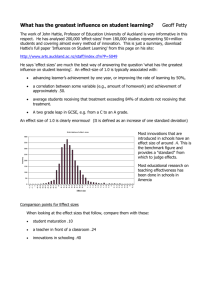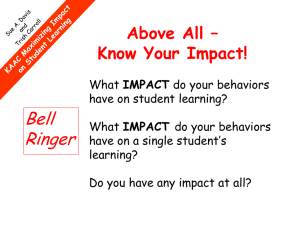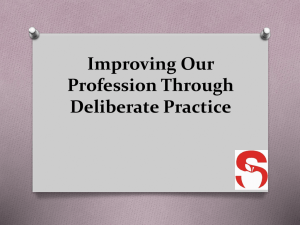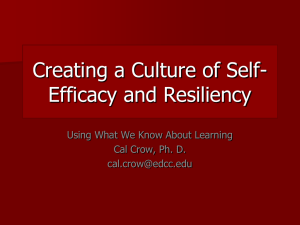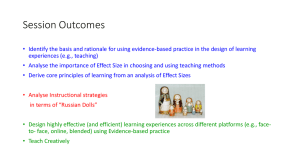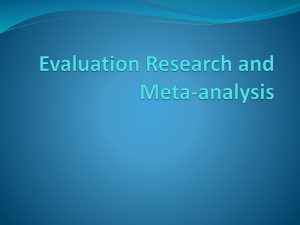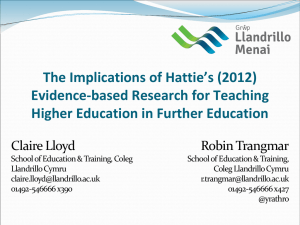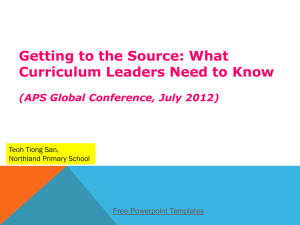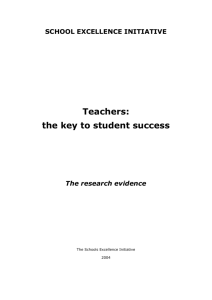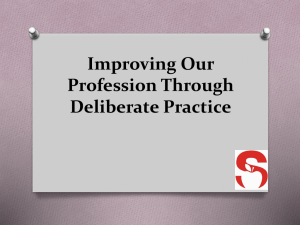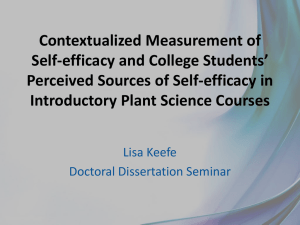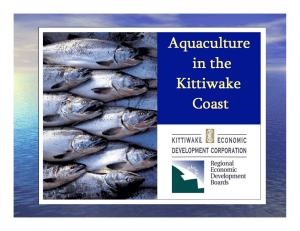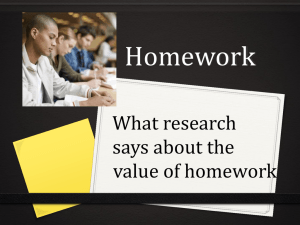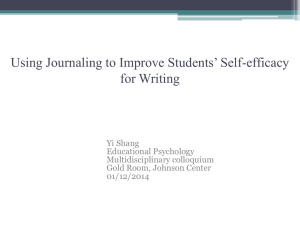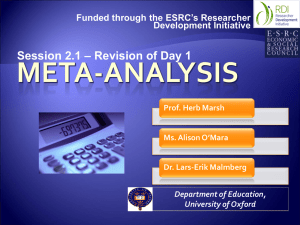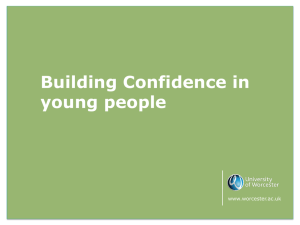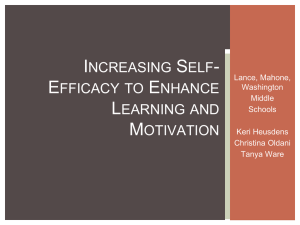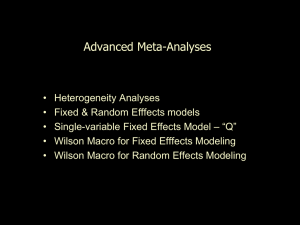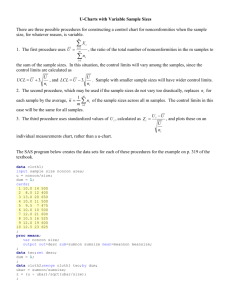Visible Learning Session 2
advertisement
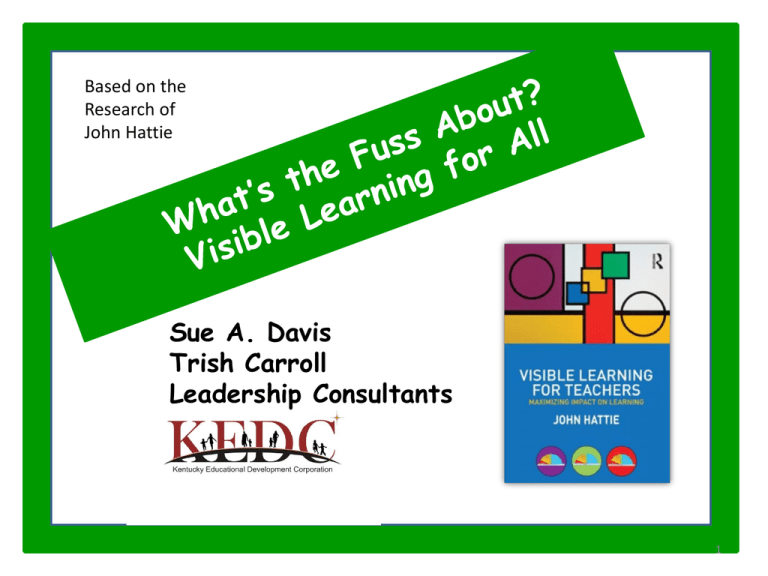
Based on the Research of John Hattie Sue A. Davis Trish Carroll Leadership Consultants 1 Please, with an elbow partner, discuss this statement and the questions related to it from your handout. From page 154 1.What are your reactions to “The major reason for administering tests in classrooms is for teachers to find out what they taught well or not, who they taught well or not, and where they should focus next. If a test does not lead to a teacher evaluating these claims, it was probably a waste of everybody’s time and effort.” this statement? 2.How would you begin the discussion of this concept within your PLC? 3. What are some ways teachers can weave more opportunities to give students feedback into their lessons? 2 MOVING FORWARD Sept. 2011 KCAS The Four Pillars Assessment Literacy Characteristics of Highly Effective Teaching and Learning Leadership Student Success 3 Assessment Literacy – “the knowledge about how to assess what students know and can do, interpret the results of these assessments, and apply these results to improve student learning and program effectiveness.” (Webb, 2002) Assessment Literate Educators Possess these Skills: 1. How to define clear learning goals. 2. How to make use of a variety of assessment methods to gather evidence of student learning. 3. How to analyze achievement data and make good inferences from the data gathered. 4. How to provide appropriate feedback to students. 5. How to make appropriate instructional modifications to help students improve. 6. How to involve students in the assessment process, and 7. How to engineer an effective classroom assessment environment that boosts student motivation to learn. (SERVE Center, University of North Carolina, 2004) 4 Effect Sizes of Influences on Achievement from John Hattie 1.6 1.4 1.2 1 0.8 0.6 0.4 0.2 0 -0.2 -0.4 The benchmark: 0.40 + one year’s learning over one year’s time Effect sizes greater that 0.40 accelerate student learning. 5 6 7 Teacher Credibility Rank 4 of 150 Effect Size 0.9 Classification High Effect Student perceptions of a given teacher’s strengths and weaknesses are consistent across the different groups of students they teach. Moreover, students seem to know effective teaching when they experience it: student perceptions in one class are related to the achievement gains in other classes taught by the same teacher. Most important are students’ perception of a teacher’s ability to control a classroom and to challenge students with rigorous work. MET Project: Measures of Effective Teaching, p.9. 8 Student “C” C C C C C C C What Students Say Care My teacher really tries to understand how students feel about things. Control Students in this class treat the teacher with respect. Our class stays busy and doesn’t waste time. Clarify My teacher explains topics in a variety of ways and makes difficult things clear. Challenge In this class, we learn a lot almost every day. We learn to correct our mistakes. Captivate My teacher makes lessons interesting. I like the ways we learn in this class. Confer Students speak up and share their class work. My teacher respects my ideas and suggestions. Consolidate My teacher checks to make sure we understand. Comments about my work help me to understand how to improve. 9 The Beliefs and Commitments of Expert Teachers—Five Attitudes 1. Expert teachers identify … the most important ways in which to represent their subject. 2. Expert teachers create … an optimal classroom climate for learning. 3. Expert teachers monitor … learning and provide feedback. 4. Expert teachers believe … that all students can reach the success criteria. 5. Expert teachers influence…students’ surface AND deep understanding. 10 Above all, the expert teacher embraces the understanding that she/he has a tremendous impact on student learning. His/her behaviors influence learning. 11 We must use “Effect Size” as a Starting Point for Discussion rather than an End Point for Making Decisions. We cannot assume that the more we “implement” strategies that produce the highest effect sizes, the better students will learn. There appears to be conflicting information that gives us reason to be cautious. 12 Teacher Subject Matter Knowledge Rank 136 of 150 Effect Size 0.09 Classification Low Effect Back to Attitudes of Expert Teachers – they can identify the most important ways to represent their subject. In Visible Learning, it was shown that teachers’ subject-matter knowledge had little effect on the quality of student outcomes! The distinction is less the “amount” of knowledge and less the “pedagogical content knowledge”, but more about how teachers see the surface and the deeper understandings of the subjects that they teach. Expert teachers differ in how they organize and use their content knowledge. Experts possess knowledge that is more integrated in that they can combine the introduction of new subject knowledge with students’ prior knowledge; . . . Read from page 28. 13 Homework On “lists of effect sizes,” homework has an effect size of d=0.29, tied with “Home Visiting” at 94th out of 150 influences. By reading further in the discussion, we learn these three things: First, homework was studied AS IT HAS HISTORICALLY BEEN ASSIGNED. Second, for high schools students, homework had an EFFECT SIZE OF .50. Third, for elementary school students, homework had an EFFECT SIZE OF –.08. Questions: Why would this be true? And, does this mean we should eliminate homework? BETTER STUDY HABITS SKILLS FOR OLDER KIDS, INAPPROPRIATE DEVELOPMENTALLY …. 14 We must use “Effect Size” as a Starting Point for Discussion rather than an End Point for Making Decisions. We cannot assume that the more we “implement” strategies that produce the highest effect sizes, the better students will learn. There is seemingly conflicting information 15 Clarity of “Success Criteria” - Success criteria let students know when they have achieved the learning goal. They must include: A. CHALLENGE DEPENDS ON WHAT STUDENTS ALREADY KNOW, SO TEACHERS MUST KNOW STUDENT’S PRIOR LEVELS OF ACHIEVEMENT AND DISPOSITIONS. Not too difficult. Students need to know about 90 % of the task. B. COMMITMENT FROM STUDENTS OFTEN OCCURS WHEN TEACHERS CREATE CHALLENGING LESSONS. This is a critical part of teacher planning. C. CONFIDENCE—STUDENTS MUST FEEL THEY CAN ACHIEVE THE LEARNING GOAL. D. “HIGH EXPECTATIONS” HAS THE HIGHEST OF ALL EFFECT SIZES. Students have reasonably accurate understandings of their levels of achievement. E. CONCEPTUAL UNDERSTANDING—STUDENTS NEED TO DEVELOP SURFACE, DEEP AND CONCEPTUAL UNDERSTANDINGS, SO ALL 3 LEVELS SHOULD BE INTEGRATED. 16 Examples of surface, deep and conceptual levels of thinking (p. 55) Levels of Understanding Learning Intentions Success Criteria Uni/Multistructural Recognize that light/sound I can name one or more are forms of energy and properties of light and have properties sound Relational Know that sound/light can I can explain how be transformed into other light/sound is transformed forms of energy. into other types of energy. Extended Abstract Understand how light/sound allows us to communicate. I can discuss how light/sound enables us to communicate. 17 p. 45 Self-efficacy is the confidence or strength of belief that we have in ourselves that we can make our learning happen. • Sees hard tasks as challenges rather than tries High to avoid them. self-efficacy • Sees failures as chances to learn and to make a greater effort or to look for new information next time. • Is more likely to avoid difficult tasks, which are Low viewed as personal threats. self-efficacy • Has low or weak commitment to goals. • Sees failures as chances to dwell on personal deficiencies, obstacles encountered or to deny personal agency. • Is slow to recover a sense of confidence. 18 Definitions and examples for teachers to consider in understanding students as they prepare their lessons. Page 46 Page 47 Page 47 Page 47-48 Page 48 Page 49 Page 49 Page 50 Page 51 Self-handicapping Self-motivation Types of Student Goals: Master, Performance, Social Social Goals: Approach / Avoidance Self-dependence Self-discounting and distortion Self-perfectionism Hopelessness Social comparison 19 Hopelessness • The student expecting that achievement gains will not occur for him or her and that he or she Refers to … is helpless to change the situation. Occurs when… • The student avoids and does not engage in achievement tasks. • The student protects his or her sense of self by gaining reputation or success from other activities (i.e., naughty behaviors) • The student does not see that achievement gains are due to his or her actions or in his or her control. • The student learns to devalue school learning. • Contexts are harsh, overly demanding or punitive. 20 Part of the climate of the classroom is affected by the climate of the school community. In one particularly interesting study of the ramifications of trust, it was found that the higher the level of relational trust among the school community—principals, teachers, students and parents — the greater the student improvement on standardized tests. In such an environment, not only are errors tolerated, but they are welcomed and understood as a vital part of the learning process. Together climate and trust are necessary for students to gain the most from making errors and to maximize their learning. 21 Making it “okay” to make mistakes and using them as springboards to better, higher learning, teachers communicate a valuable lesson about life in general. By not expecting perfection the first time every time, the teacher reinforces the notion that we can grow smarter, better, and more capable. 22 Learning requires two major skills: Concentration Deliberate Practice 23 Deliberate Practice . . . … must be designed to improve performance. . . (Opportunities for practice must have a goal & evaluation criteria); … must be based on authentic tasks . . . (The practice must use real work and be performed in context); … must be challenging . . . (The tasks selected for practice must be slightly outside the learners comfort zone, but not so far out as to produce anxiety or panic); … must have immediate feedback on results . . . (Diagnostic feedback must be rapid and continuous), and … must include reflection and adjustment . . . (Feedback requires reflection and analysis to inform behavior change). (10,000 hours. For complex work, ten years seems to be the necessary investment of deliberate practice to achieve expertise. Malcolm Gladwell drew attention to the 10,000 hour rule in his book Outliers). 24 Feedback . . . Three Feedback Questions: Teachers and students ask 1. Where am I going? 2. How will I get there? these questions of 3. Where do I go next? themselves and each other – separately and together. Three Feedback Levels: 1. Task or Product Level How does it “look?” Did I do the right things? 2. Process Level 3. Self Regulation Level How do I think I did and what can I do now? 25 “Give dollops and dollops of feedback,” says Hattie about the most effective teacher activity for student learning. Feedback Advice – * * Don’t mix praise with feedback. Rapid formative assessment is more effective than a longer school day, more rigorous math classes, class-size reduction and 19 other influences and is the MOST COST EFFECTIVE. 26 Teacher Collaboration... The most successful method Hattie encountered for this collaboration is the “DATA TEAMS” MODEL IN WHICH SMALL TEAMS OF TEACHERS MEET EVERY TWO TO THREE WEEKS AND FOLLOW A SPECIFIC STRUCTURE TO EXAMINE STUDENT DATA, SET INCREMENTAL GOALS, ENGAGE IN DISCUSSION ABOUT GOALS AND IMPROVING INSTRUCTION AND CREATE A PLAN TO MONITOR LEARNING AND INSTRUCTION AND THEN REPEAT THE CYCLE. IT IS NOT IMPORTANT EXACTLY WHAT FORM THESE TEAMS TAKE—WHETHER THEY ARE PLC's OR NOT. WHAT IS IMPORTANT IS THAT TEACHERS ARE OPEN TO LOOKING AT EVIDENCE OF THEIR IMPACT ON STUDENTS AND CRITIQUING EACH OTHER’S IMPACT TO BETTER MEET THE NEEDS OF STUDENTS. 27 Important “Take Away’s” from this Session … 1. Effect Size is a starting point for discussion, not an end point for decision-making. 2. Students know who the most credible teachers are. 3. Expert teachers have rigorous beliefs about themselves and what they can do for student learning. 4. Teachers must establish and then communicate the success criteria for any lesson. 5. Self-efficacy can make, or the lack of it can break, student learning. 6. Learning requires concentration and deliberate practice. 7. Teachers need to give “dollops and dollops” of feedback. 8. School leaders must provide time for teacher collaboration. 28 “By changing nothing, nothing changes.” Celestine Chua 29 Sue.davis@kedc.org Trish.carroll@kedc.org Donetta.trimble@kedc.org
